April 27, 2020
Monday, May 11, 2020
Share
Another cold rainy day. Thought we’d get back to horse training for a brief message. We’ve gone over the basics of handling and starting a young horse or one new to training. Next thing to do is to continue to apply those principles while getting the horse comfortable to new experiences in short enjoyable sessions. Take the animals for a walk and you can start getting it used to voice commands, say “walk” when starting and “whoa” just before stopping. Use a clear calm voice, but don’t be harsh or overly loud. It’s a polite “ask”, with an expected response, not a military drill.
Once the horse gets the general idea of starting and stopping at your side (I like the horse’s head even with my shoulder) one with a loose lead, or pehaps a slight a slight pressure/release on the lead rope, you can teach him/her to stand squarely (one foot in each corner under the body). Do this slowly, maneuvering the leadrope and almost rocking the horse forward or back with a “g-o-o-o-d” when you get the correct response. Then scratch it while it stands correctly and you can teach it another voice command, “stand”. Then say “walk” and start off again. Once it gets the idea on how to move it’s feet on command (slight lead rope pressure) you can teach it to back up a few steps. Again, it goes back to posture, when backing you want it to drop it’s head and slowly take one step back at a time; with minimal lead-rope pressure so it’ll back up slowly with a simple “back” command and little jiggle of the lead rope.
Lead the animal to new and interesting places. Tradition is to be on the animal’s left side; but teach it to lead you from each. You want it comfortable with anything and it’ll have posture benefits. If it gets nervous, calm it with an “easy” and stroke on the neck. Another thing you can do to settle it down is find a grassy safe area and do the “untracking” and “focus” activities; depending on just how worked up it is. Let the horse stop and look at what is making it nervous; and look at it yourself to show that you see it but that it isn’t anything to be overly concerned about. The idea is to challenge the horse ever so slightly slightly every session while having it look to you for confidence and support. the repetition is what establishes it as safe in the animal’s mind. As it’s leader, don’t push it too much, and maintain that bubble so it doesn’t invade your space.
You can also start getting it used to objects by slowly rubbing it with a towel all over the body; have it walk over a piece of plywood on the ground. Or holding up other things, letting it see them and smell them before touching the animal with them. Best to do this without the horse being tied up. You don’t want to force the animal to accept things. I don’t think I’ve even mentioned tying up the animal in my previous sessions. Horses should learn to be tied, but I thinks it’s better if you can do some of the grooming and handling with them freely in a small pen so they get a chance to move around if they’d like. If you can make it their decision to want to be with you it’ll “force” you to think of ways to make it enjoyable for the animal. Then go ahead and tie the horse at the animal’s shoulder height to a secure object for a short time with you near it for support. Best to do this briefly and while the animal is still young. A mature horse has a lot of power and they may pull back and test it a time or two. I’ll sometimes wrap the rope around a post in a way it isn’t totally secure when training it to be tied. Then the rope will slide so the animal doesn’t exert his full strength against an immovable object.
Carry on with simple fun experiences for the animal and when you do finally first put a saddle on, or mount the animal, and you shouldn’t have to deal with a bucking bronco.
Lionel can’t face another cold, rainy, social distancing day.

